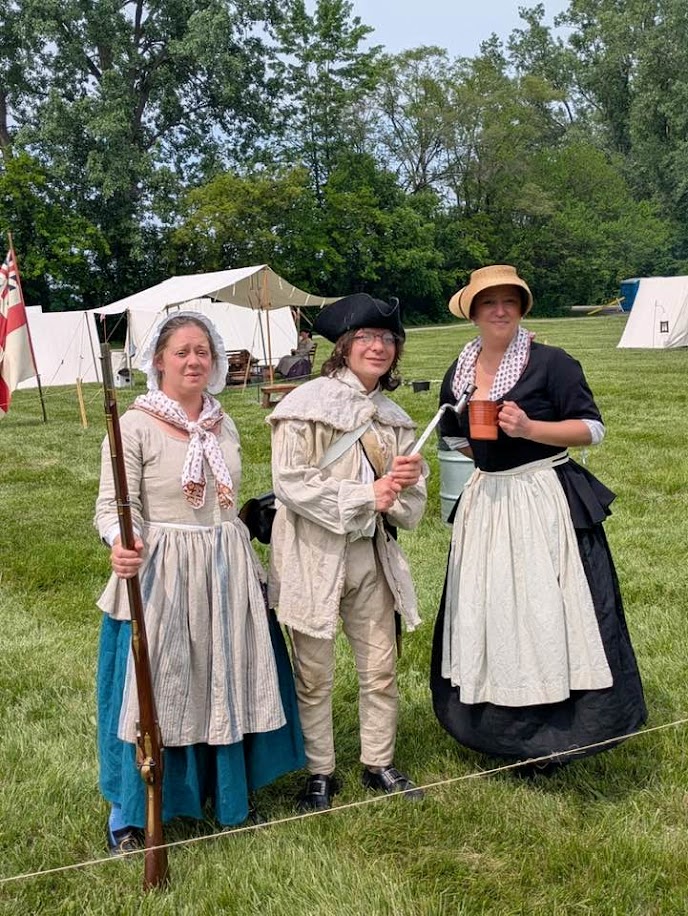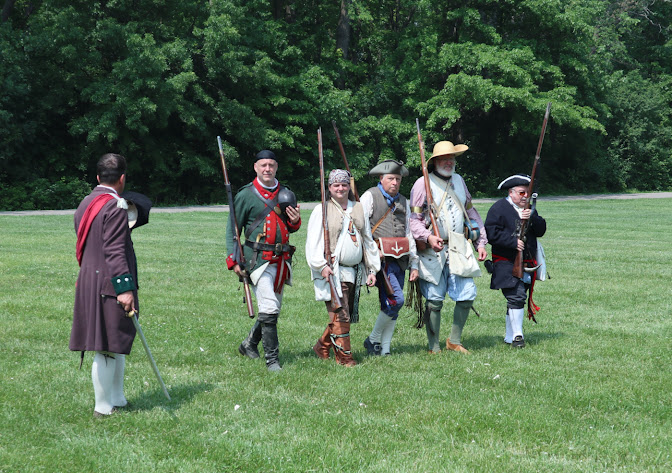It was only five years ago that everything was shut down due to covid. Well, here we are, in 2025, and things are going like gangbusters. Sadly, since 2020, we lost Colonial Kensington. However, we have the Taylor Colonial Days to replace it. It also helps that we have America 250 happening - the Semiquincentennial - and interest in this founding generation time period is growing. To be honest, interest in our nation's founding has been rekindling for close to 20 years now, beginning with the John Adams HBO miniseries in 2008, then the TV series Turn: Washington's Spies in 2014, and the Hamilton play only a year after (2015). And now we have been commemorating the 250th anniversaries of historical events that lead up to independence:
And we don't want to forget America's 200th birthday celebrations:
2022
2022
Yes---I wrote a few posts about the Bicentennial as well.
So, is it any wonder that more and more folks are showing an interest in this period?
- - -
My hat is off to the Lees (Doug, Dalton, and Sheila) and the 49th Regiment of Foot for being the hosts of the Taylor Colonial Days event at Heritage Park in Taylor (Michigan).
This is a very fine event indeed. Their first was last year (2024), and this year proved that the 2024 event was no fluke! And obviously word has spread to the participants, for there were a lot more than last year!
I have a blog-full of photos comin' at ya - - are ya ready?
 |
| Year number two! |
You know, I can'r explain the feeling that comes over me when I step out of my modern car, turn, and begin to walk in this direction...because this is what I see:
 |
| What a beautiful site that lay before me - - - - Some folk go for the beach, which is great, but this is what I go for!! |
 |
| Thanks in no small part to this family: Doug, Sheila, and Dalton Lee |
 |
| My son was flanked by Amy & Jenny~ |
 |
| With this year being the 250th anniversary of the beginning of the Revolutionary War, the past come to life at a reenactment is the best way to celebrate and commemorate. |
Reenactments such as what we have here in Taylor's Heritage Park were not very commonplace back when I was a kid. Oh, they were around, but not nearly as much as now.
 |
| And, best of all, I get to participate now! Here I am with my good friend (and colonial preacher), Norm~ |
In fact, I have made more friends since I began to reenact 21 years ago than I could ever have imagined!
 |
| Karen is a dance caller for various eras, including Colonial, Regency, and Civil War. |
 |
| Amy (in the shot with me) and Jennifer. Both ladies also do Civil War reenacting but have joined in the 18th century as well. |
 |
| The 1st Pennsylvania~ |
 |
| The French came out as well. Between 1778 and 1782 the French provided supplies, arms & ammunition, uniforms, and, most importantly, troops and naval support to the beleaguered Continental Army. |
 |
| Morning drill~ |
 |
| Morning drill~ |
 |
| Here we see the Americans and the British at morning drill. |
 |
| Even after reenacting for over 20 years, I never tire of the sound of musket fire. To the left we have the Continentals, while the British are to the right. |
Often, people get the militia and the Continentals confused. But the difference was that the Continental Army provided a more professional and centralized force, while militias offered localized defense and support.
For contemporary Americans the difference between militia and regular, or “Continental,” soldiers is hard to grasp. Both fought in the war. Both suffered casualties. Both have supporters who claim they won the war.
For all the benefits of a militia force, George Washington knew for the United States to gain its independence and to create a truly nation state, a nationalized standing army needed to be created. This professionally trained Continental Army would serve as the backbone of the American war effort with militia providing support when possible.
In part, this was due to the idea that these emergency soldiers, summoned from home on short notice, the militia lacked confidence on the battlefield.
(However), Washington and some of his generals learned to use the militia as auxiliary troops around a core of regulars with triumphant effect at battles such as Cowpens.
The visitors had shown a real and true interest in this period in history. I certainly let many know that we were at the beginning of the semiquincentennial, and some responded with telling me they remembered the bicentennial and that they couldn't believe it's already been 50 years since that celebration took place. I suppose that's another reason why I am excited about Taylor Colonial Days - more history to share and to help build up excitement for America's 250th.
Let's support our local events - they need us...and we need them to keep our hobby alive!
 |
| I absolutely love seeing the presentations - the reenactors - when they gear their talks towards the kids. It's this sort of thing that will catch and hook them and could be life-long history lovers. |
 |
| Bob Stark/Ben Franklin welcomed me to use the shaving horse that he built and sells. |
 |
| So, as I explained and presented this wood-working tool, a few interested folk gathered to watch and listen. |
Here's some fashion fun:
The shoe buckle of the eighteenth century is an alien object in the twenty-first. Shoe buckles were a characteristic feature of eighteenth-century dress and were widely worn from the 1690s onwards—forming part of the classic male ensemble of buckled shoes, stockings, breeches, and coat—though they seem to have fallen from favor a century later, as fashions changed.
But, just as fashions changed 200+ years ago, some of the older folks, just like today (moi!), clung to the fashions of their own youth.
From the excellent book "Paul Revere and the World He Lived In" by Esther Forbes:
"As the (19th) century advance(d), small boys begin to appear---all eyes, all ears, they watch 'old Mr. Revere' in church, on the street, at his foundry. Some sixty or seventy years later, when asked, they remember him well. Rowland Ellis remembers (Paul Revere) as a 'thick-set, round faced not very tall person who always wore small clothes.' The Ellis family pew in the 'New Brick Church' was directly behind that of Revere, and there Mr. Ellis says, "I used to see him as regularly as the Sabbath came."
The oddity of small clothes alone would be remembered by a small boy. The old elegance of knee-breeches, ruffled shirts, long stockings, and cocked hats had passed out of fashion years before. Others besides Paul Revere (also) clung to their picturesque costume of their youth. There were a number of these 'last leaves' about Boston. It may have been a sin for small boys 'to sit and grin...but the old three-cornered hat, and the breeches and all that, are so queer.' "
 |
| On this warm mid-70s day, I wore only linen clothing, from shirt to waiscoat to frock coat to knee breeches. |
In my modern life I still wear the clothing styles and fashions of my youth, such as band t-shirts and jeans, much as Paul Revere did the same in the early 1800s when "small clothes: (the old three-cornered hat, and the breeches and all that)" were out of fashion.
By the way, though the blank cartridges themselves are not dangerous, yes, stuff does still come out of the barrel. There's still an explosion, so the heat, bright light, flame, and gases will come out of the barrel. The hot gas that comes free can still hurt you. One should never stand directly in front of the blast of the gun. At close range, the hot gas can easily hurt, blind, or even kill you.
It is common practice at battle reenactment events to aim high when firing toward advancing soldiers. At these events, there are usually strict rules about the use of these blank cartridges.
 |
| Though this was done at a different reenactment, it still shows quite well the damage a blank black powder cartridge can do. This is what happened to a fresh, hard-skin pumpkin when a replicated period black powder musket was fired at it from 12 inches away - no bullet. Now just imagine the damage that could be done to your soft skin...yeah...these military reenactors go through training before firing on the field. |
 |
| 1st Pennsylvania~ |
Here are a few guys from various regiments together - "Continental army" soldiers.
 |
| The 49th Regiment of Foote with a Brunswicker soldier in the striped overalls in the back rank.~ |
Here we have the NWTA commander in the brown and green coat,
a Butler's Ranger in the green and red coat,
and four members of Campau's Company French Militia.
 |
| The NWTA commander giving honor to the 1st Pennsylvania~ |
 |
Closing ceremony on Sunday afternoon - the battle had ended. I believe the British won the day on Sunday. |
As you can see, it was a very good reenactment - one that I feel will continue to grow. But with folks like the Lee family heading it up, you can be sure it will be top-notch!
This year of 2025 I turned 64. That's not exactly young. But it is not too old to still enjoy myself and participate at these reenactments. Oh, I don't do military, as you probably know, so I do not have to march and drill in the hot sun. Instead, I can enjoy times past 'neath the shade of a tree, if I must.
Over the coming weeks and months there will be multiple time-travel opportunities to take part in, including more time at the cabin, a few time-line events, the wonderful 4th of July at Mill Race Village gathering and celebration, multiple Revolutionary War reenactments with soldiers and battles (Frankenmuth and Vermillion Creek to name two), and even a couple of Civil War events. Oh! And a few more posts on our Massachusetts trip! And that's not counting my period-dress Greenfield Village visits!
Yes, God willing, I will have a wonderfully busy summer, and even fall (harvest time!) and winter, ahead of me to spend in the past.
And I plan to post those I attend right here on Passion for the Past: damn the torpedoes, full speed ahead!
Until next time, see you in time.
Thank you to Karen Dunnam, Norm Gerring, Jennifer Long, Amy Pempeit, and Richard Reaume for joining me in the photography department.
To visit the 2024 Taylor event, please click HERE
~<><><>~








2 comments:
Ken: As usual, you have outdone yourself with great pictures and commentary.
Thank you - - that really means a lot to me!
Post a Comment